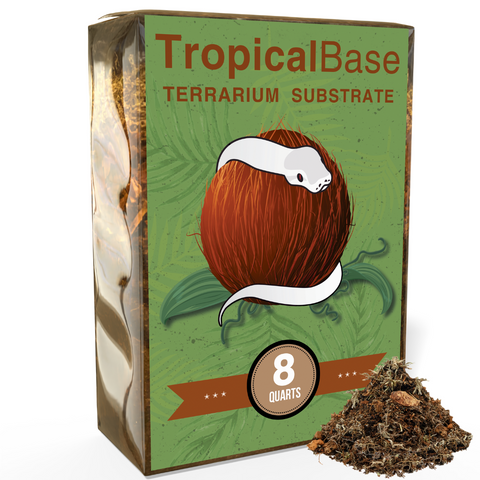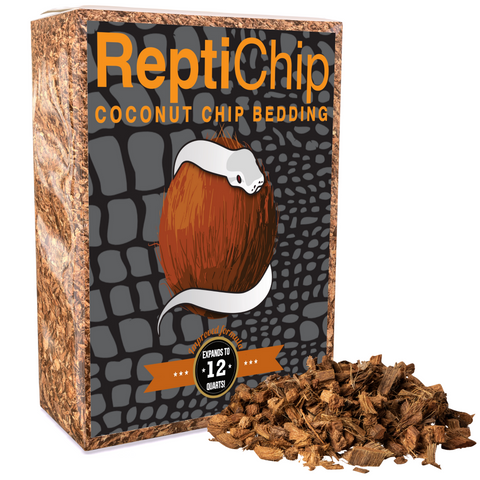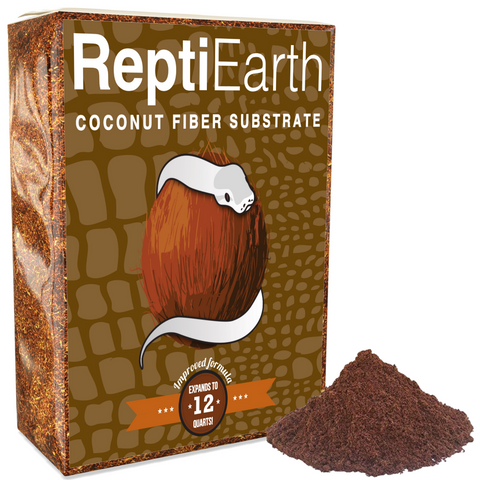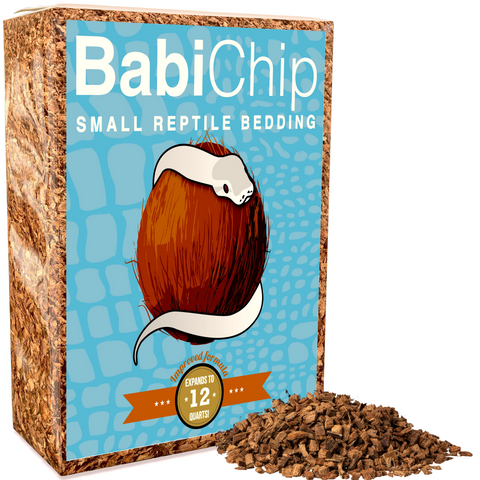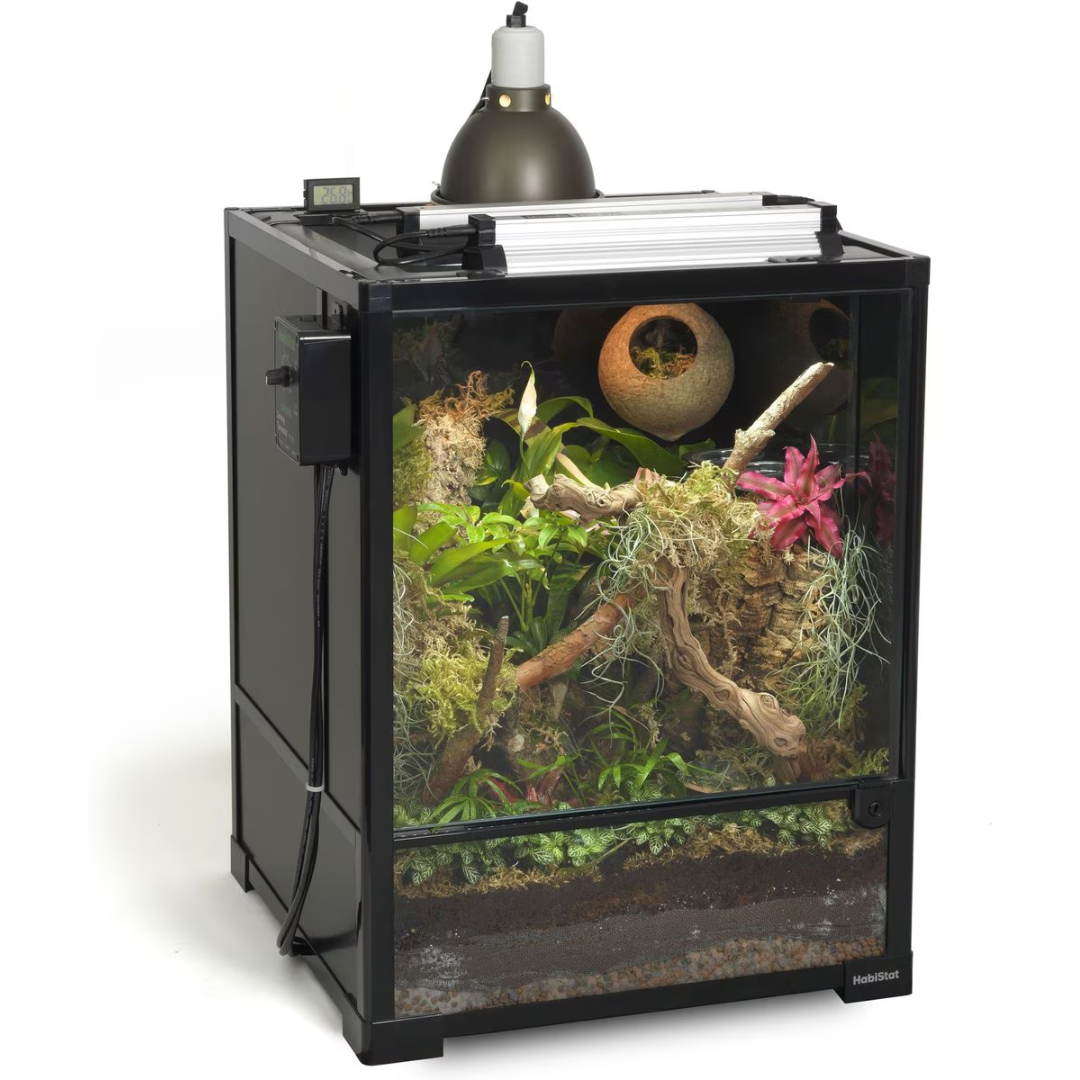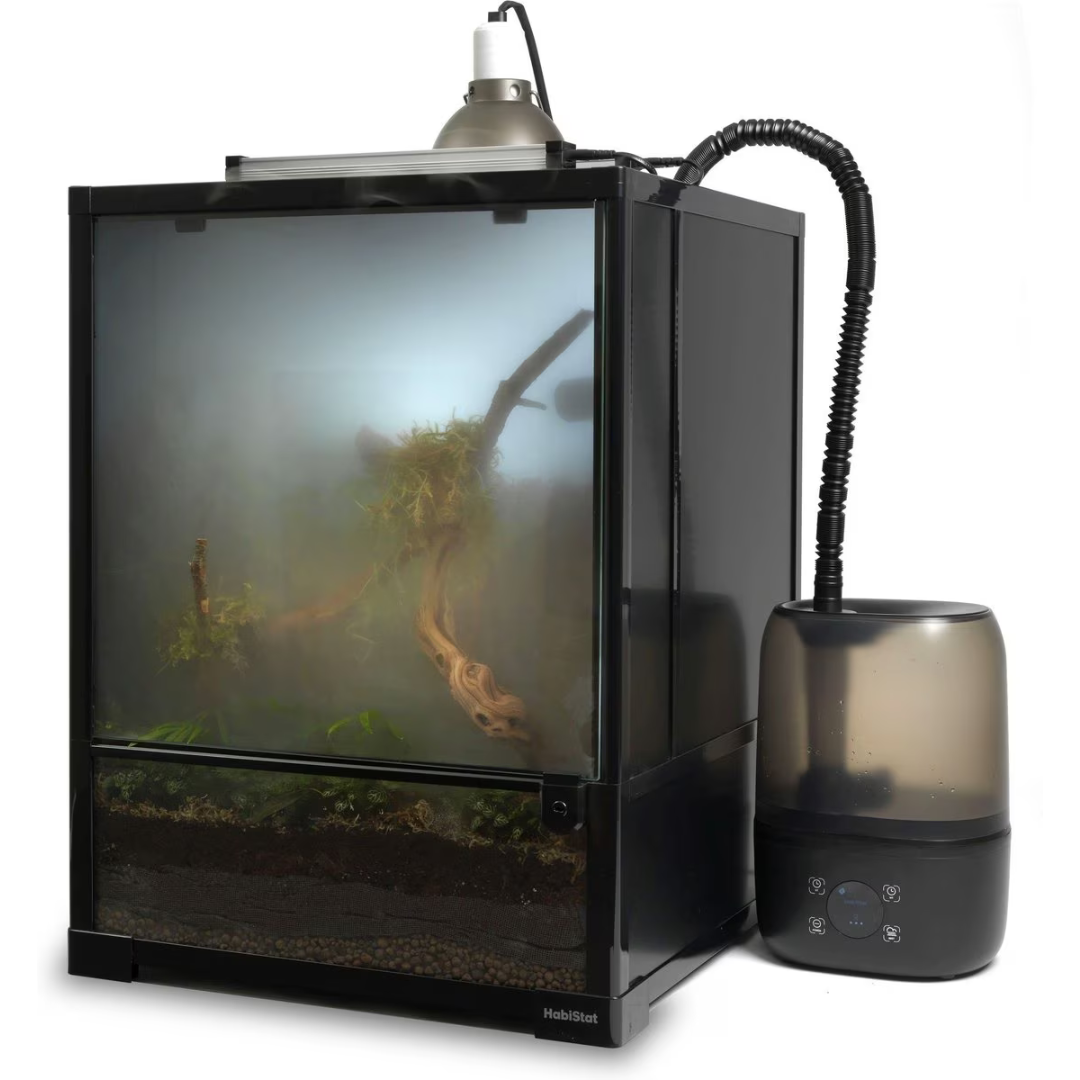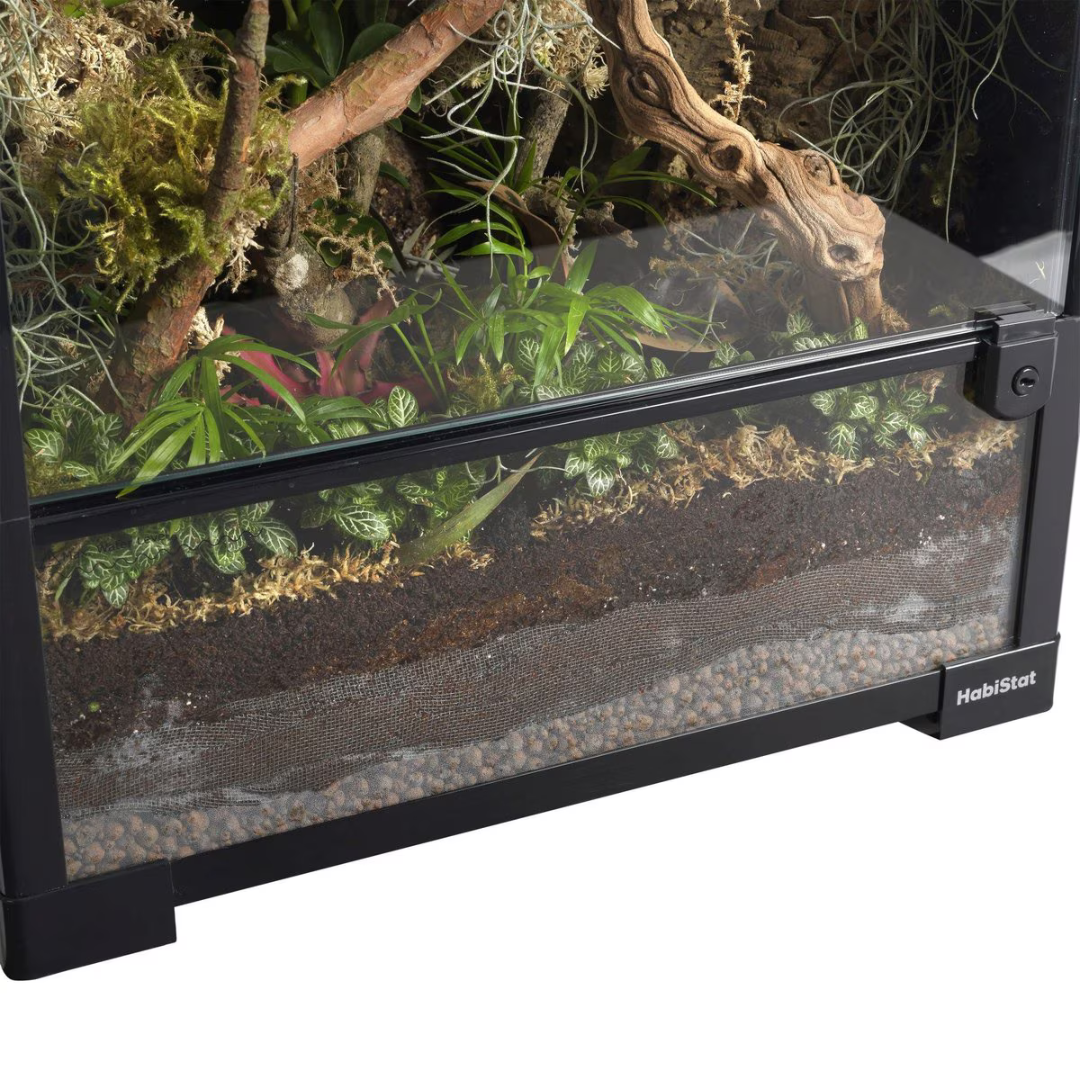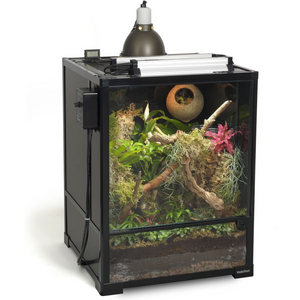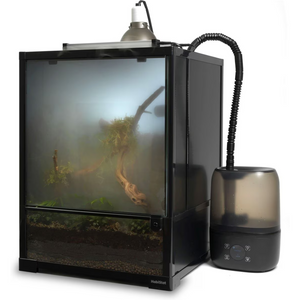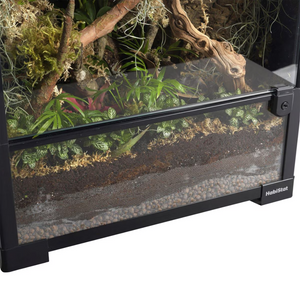Natural History
The Halmahera gecko, a large, tropical wall-dwelling gecko indigenous to the Halmahera Islands and surrounding regions of eastern Indonesia, follows a complex and fascinating life cycle shaped by the warm, humid climate of its native range. Hatchlings emerge from eggs after an incubation period of approximately 60 to 90 days, depending on ambient temperature and humidity levels. The gecko is an oviparous species, meaning it reproduces by laying eggs, and females typically produce clutches of two leathery-shelled eggs. These are often adhered to surfaces such as tree bark, crevices in rock outcroppings, or leaf axils, where environmental conditions help regulate development. There is no parental care post-oviposition; the young are fully independent upon hatching and instinctively know how to avoid predators and find food. In the wild, juveniles grow rapidly during their first year, reaching sexual maturity by 18 to 24 months. With proper care and environmental conditions, these geckos can live 10 to 15 years in captivity, though wild individuals may experience shorter life spans due to predation and environmental pressures.
Halmahera geckos display a variety of distinctive behaviors that reflect their adaptations to a rainforest lifestyle. These geckos are primarily nocturnal, becoming active shortly after sunset when their large, lidless eyes give them an advantage in low-light conditions. During the day, they remain hidden in tree hollows, under bark, or among dense foliage, carefully avoiding predators and conserving moisture. Their arboreal nature means they are most at home on vertical surfaces, using specialized toe pads equipped with lamellae to grip nearly any texture, from smooth leaves to rough bark. They are solitary in nature and can display territorial behavior, especially males, which may become aggressive toward one another when overlapping territories or competing for mates during the breeding season. Aggression is typically expressed through vocalizations, open-mouth displays, and tail waving before escalating to physical confrontation.
In terms of feeding, the Halmahera gecko is an opportunistic insectivore, feeding on a wide range of arthropods such as beetles, moths, spiders, and caterpillars. In its natural habitat, it may also consume soft fruits, nectar, or even small vertebrates when available. Their hunting strategy involves slow, deliberate stalking followed by a rapid strike, often completed with a quick shake of the head to incapacitate prey. Their vocalizations are especially notable; they produce a series of chirps, clicks, and even barking sounds used in both courtship and territorial disputes—one of the reasons they are sometimes referred to as "barking geckos."
Ecologically, the Halmahera gecko plays a critical role in maintaining the balance of its native rainforest environment. As both predator and prey, it occupies a mid-level position in the food chain. By consuming large quantities of insects, it helps control pest populations, some of which may otherwise damage plant life or spread disease. In turn, it provides a food source for larger arboreal snakes, birds of prey, and small carnivorous mammals. This gecko’s cryptic coloration—usually shades of brown, grey, and lavender with mottled patterns—provides effective camouflage amid bark and forest debris, enhancing its ability not only to ambush prey but also to avoid predators.
Adaptations specific to its humid, equatorial environment include a high tolerance for moisture, resistance to fungal infections, and skin that both retains water and allows for regular shedding. Shedding is a critical biological function that occurs every few weeks; the gecko removes old skin in patches, often eating it afterward to recycle nutrients and avoid leaving traces that could alert predators to its presence. Its ability to vocalize, adhere to virtually any surface, and blend seamlessly with its environment all contribute to its success as a rainforest predator. Understanding these behavioral and ecological traits is critical for anyone seeking to responsibly keep the Halmahera gecko in captivity, as its welfare depends on replicating many of these natural conditions.
Conservation Status
The Halmahera gecko is currently classified as "Least Concern" on the IUCN Red List. This status indicates that the species is not at immediate risk of extinction and maintains relatively stable population trends across its natural range. The designation reflects that the Halmahera gecko has a wide distribution across the Maluku Islands, particularly in northern regions such as Halmahera and Ternate. While not abundant in all parts of its range, its presence in multiple island habitats helps to buffer the species against localized population losses. Overall, the species exhibits a level of resilience owing to its adaptability to both primary and secondary forest environments, as well as in areas with moderate human disturbance.
Despite the Least Concern classification, the Halmahera gecko still faces several threats that could impact its population over time. One of the most significant concerns is habitat destruction due to logging and land conversion for agriculture, particularly the development of palm oil plantations and subsistence farming. As forest cover continues to decline throughout Indonesia, suitable habitat becomes increasingly fragmented, affecting the gecko’s capacity to forage, reproduce, and find shelter. In addition, collection for the international pet trade poses a substantial risk in some areas. The species is visually striking and relatively large for a gecko, making it desirable among reptile hobbyists. Unregulated or unsustainable harvesting pressures can result in localized population declines, especially when wild-caught individuals are preferred over captive-bred ones.
There is also growing concern about the spread of invasive predators and pathogens that can negatively affect native gecko populations. Non-native species such as rats and feral cats can prey on both juvenile and adult geckos, whereas the introduction of fungal or bacterial diseases may go unrecognized in wild populations due to limited field monitoring. Although the Halmahera gecko shows some adaptability to human-altered environments, the combination of these stressors could lead to more pronounced population declines if not addressed through conservation actions.
In response to these challenges, a number of conservation measures have been implemented or proposed to safeguard the Halmahera gecko. Protected area networks and forest reserves in the Maluku Islands contribute indirectly by preserving critical habitats for many local species, including this gecko. Indonesia's national wildlife protection laws regulate the collection and export of native reptiles, though enforcement remains inconsistent. Within the international pet trade, increasing interest in captive breeding has helped reduce the number of wild-caught individuals entering the market. Several captive breeding programs, both in Indonesia and abroad, have successfully maintained viable populations of Halmahera geckos, contributing not only to genetic diversity but also to potential reintroduction efforts, should the need arise.
Efforts to raise awareness about sustainable harvesting and responsible pet ownership are also gaining traction within the reptile-keeping community. Educational outreach and collaboration with local communities may enhance compliance with conservation regulations, reduce poaching pressures, and support long-term species survival. While the Halmahera gecko does not currently face imminent extinction, continued conservation vigilancy is essential. With ongoing habitat protection, reinforced legal measures, and expanded captive breeding, the species stands a strong chance of maintaining its Least Concern status into the future.
Native Range
The Halmahera gecko is native to a restricted range within the northern Maluku Islands of eastern Indonesia, with its primary distribution centered on Halmahera Island, the largest island in the archipelago. Its presence has also been recorded on neighboring islands such as Morotai and Bacan, though these populations are less documented and may represent either natural extensions or introductions. The species is considered endemic to this region, with no populations naturally occurring outside of the Maluku Islands. The isolation of these islands and their tropical positioning near the equator contribute to the gecko’s reliance on consistently warm and humid environmental conditions throughout the year.
The macrohabitat of the Halmahera gecko consists predominantly of lowland tropical rainforest, a biome characterized by dense vegetation, multilayered canopy cover, and a high degree of biodiversity. These forests receive consistent rainfall year-round and exhibit minimal seasonal variation in sunlight or temperature, providing a stable environment ideal for arboreal reptiles. Halmahera’s tropical rainforest ecosystem includes both primary and secondary forest, with the gecko primarily associated with undisturbed, mature forests but also adapting to partially degraded areas where sufficient tree cover remains.
Within this macrohabitat, the species exhibits strong preferences for specific microhabitats. It is primarily arboreal and is most frequently found on the trunks and branches of large trees, especially those with loose bark or crevices that provide cover during the day. The gecko may also inhabit vertical rock faces, fallen logs, or the shaded interiors of tree hollows. At night, it becomes active and hunts across all vertical surfaces, avoiding open ground and brightly lit areas. Though largely forest-dependent, the species can be found near forest edges and sometimes within coconut plantations or other semi-natural landscapes that still provide humidity and structural complexity.
Climatically, the Halmahera gecko thrives in equatorial conditions, with ambient temperatures ranging from 75°F to 88°F, rarely dipping below 72°F even at night. Relative humidity remains high year-round, typically between 75% and 95%, supported by frequent rainfall. The region experiences a humid tropical monsoon climate, with precipitation peaking between November and April but rainfall occurring during all months. These conditions contribute to the gecko’s physiological requirements for high ambient moisture, particularly for hydration, skin health, and successful shedding. This species is not adapted to prolonged dry periods and relies heavily on the ambient moisture in its environment.
In terms of elevation, the Halmahera gecko is found primarily at lowland elevations, typically from sea level to around 1,000 feet. Sightings beyond 1,300 feet are uncommon, as the species appears to prefer the warm, stable microclimates of low to mid-elevation forests. Elevation influences not only temperature and humidity levels but also vegetation structure and availability of microhabitats. These geckos are most successful in areas where there is a dense canopy, which helps maintain high humidity levels and provides vertical surfaces and cover.
Key environmental factors critical for the survival of the Halmahera gecko include the presence of large trees with textured bark or peeling layers, which offer both shelter and hunting grounds. Access to water, primarily in the form of ambient humidity and dew condensation rather than standing bodies of water, is essential. Leaf litter and mossy trunks enhance insect prey availability, while shaded understory and vertical refuge sites help regulate body temperature and protect against predators. Forest continuity and minimal human disturbance are crucial, as habitat fragmentation and logging reduce canopy cover and microhabitat diversity, impairing the gecko’s ability to thermoregulate and reproduce successfully.
Overall, the Halmahera gecko’s highly specialized adaptation to warm, humid, forested zones within a geographically confined range underscores the importance of environmental stability and microhabitat integrity for its long-term survival.
Behavior
The Halmahera gecko is predominantly nocturnal, meaning it is most active during the night. In its native tropical habitat—humid, lowland and coastal forest environments of eastern Indonesia—it emerges after dusk to forage and exhibit territorial behavior. This species spends daytime hours sheltered in tree hollows, under loose bark, or within foliage, often in high humidity microhabitats which prevent dehydration. Seasonal changes do not significantly alter its nocturnal activity patterns due to the stable, equatorial climate. However, slight increases in foraging and courtship behaviors are observed during the rainy season, which aligns with its peak breeding period. In captivity, nocturnal patterns persist, although some individuals may exhibit limited crepuscular activity during dawn or dusk if stimulated by feeding or environmental changes.
Socially, the Halmahera gecko is a solitary and highly territorial species, particularly among mature males. In the wild, individuals establish overlapping home ranges but defend core areas, especially around preferred hiding spots or basking sites. Dominance hierarchies are evident in shared environments, with larger and more robust geckos asserting control over resources through visual displays and physical posturing. During the breeding season, males exhibit increased aggression toward rivals, using vocalizations and tail waving as warning signals. Courtship involves a combination of tactile stimulation, body vibration, and vocal chirps emitted by the male. After successful copulation, females lay clutches of two leathery-shelled eggs, typically in secluded, humid crevices. No parental care is provided post-oviposition; the young are independent upon hatching.
This species is highly responsive to environmental stimuli, using a combination of visual, olfactory, and tactile cues to navigate and survive. It possesses large, light-sensitive eyes adapted for low-light environments, allowing it to detect movement and distinguish prey at night. Changes in ambient temperature and humidity directly influence its behavior; for instance, it increases surface activity and exploratory behaviors following rain, which mimics natural conditions that stimulate insect emergence. In cooler or drier periods, activity declines, and the gecko seeks shelter to conserve moisture and regulate body temperature. In cooler months or during periods of environmental stress, semi-brumation may occur, characterized by reduced movement and feeding, especially in captivity under suboptimal conditions.
When detecting prey, the Halmahera gecko relies on motion detection and chemical cues, using its highly developed Jacobson's organ as it tongue-flicks in the presence of invertebrates. It strikes with precision using a quick jaw snap, often favoring soft-bodied arthropods. In contrast, its primary response to predators includes retreat, body flattening, or tail displays that serve as a distraction. If cornered, it may vocalize or perform a bluff display by gaping its mouth to reveal a brightly colored lining as an intimidation tactic. Tail autotomy is another defensive strategy; the tail detaches easily and continues twitching to divert the predator’s attention, while the gecko escapes.
Notably, the Halmahera gecko displays unique locomotion traits—its broad toe pads equipped with specialized setae enable it to adhere to a wide range of surfaces, including smooth vertical surfaces and ceilings. This gecko also exhibits a distinctive defensive behavior known as "barking," an audible vocalization rare among geckos of its size, used to deter threats and assert territory. Additionally, it engages in thermoregulatory basking under forest canopies or human structures at night, utilizing retained radiant heat from surfaces to regulate its core temperature. Unlike many reptiles, this species avoids open basking in direct sunlight, instead relying on subtle heat sinks within its microhabitat.
In captivity, behavior can deviate from wild norms depending on enclosure setup, lighting schedules, and human interaction. While still nocturnal, individuals may adjust their schedules slightly based on artificial lighting and feeding times. Territorial aggression often escalates in confined spaces, particularly among males, making solitary housing the standard recommendation. Feeding responses are often more vigorous in captivity due to regular meal provision and lack of foraging challenge, which can lead to obesity if not managed properly. Stress responses include discolored skin, excessive hiding, and reduced feeding, often triggered by improper temperature, low humidity, or frequent handling. Enrichment, such as live insect feeding, varied climbing structures, and seasonal lighting variations, can help replicate natural conditions and reduce stereotypic behaviors.
Captivity Requirements
Enclosure Design
Halmahera geckos are large, semi-arboreal lizards native to the forests of Indonesia, and their enclosure design must accommodate their size, climbing behavior, and environmental needs. Juvenile Halmahera geckos can be housed in enclosures measuring a minimum of 1 foot long by 1.5 feet tall by 1 foot deep. However, they grow quickly, and adult habitats should measure no less than 3 feet tall by 1.5 feet wide by 1.5 feet deep. larger enclosures are ideal, as these geckos frequently climb and require vertical space for exploration, thermal regulation, and exercise.
Recommended enclosure materials include PVC or sealed wood, which retain heat and humidity better than glass while remaining durable and easy to clean. Glass front panels can be used to provide visibility, but the enclosure should have ample ventilation—ideally a combination of front and top vents—to prevent stagnant air and mold growth in the consistently humid conditions required by this species.
The internal layout should replicate a moist forest environment with abundant vertical and horizontal climbing opportunities. Large branches should be securely fastened to allow for climbing, and cork rounds or driftwood should be included for visual barriers and elevated basking spots. Multiple hides are essential—at least one on the cooler end of the enclosure and another on the warmer side, with moss-lined hide boxes to facilitate shedding. A large piece of cork bark placed vertically works well as both a basking spot and a hiding place. Live or artificial plants, either fixed or in weighted pots, offer additional cover and reduce stress by mimicking the gecko's natural habitat.
Due to the strength and activity level of Halmahera geckos, secure enclosure locks or latch systems are vital. They are known to push against loose screens or latches, so screen-top enclosures must be reinforced, and front-loading doors should be lockable to prevent escape.
Lighting and Heating
Halmahera geckos are crepuscular and benefit from low levels of UVB radiation, which supports vitamin D3 synthesis and calcium metabolism. A 5-7% UVB tube, such as a T5 high-output strip, should be mounted inside the enclosure approximately 6 to 8 inches above where the gecko will bask. The fixture should run the length of the enclosure to provide a gradient of UVB exposure, and it must be replaced every 12 months or as recommended by the manufacturer.
Temperature gradients are crucial to thermoregulation. The basking area should reach 85 to 88 degrees Fahrenheit using a ceramic heat emitter or deep heat projector, controlled by a thermostat and directed toward the upper basking zone where the gecko rests. The ambient daytime temperature across the enclosure should average between 78 and 82 degrees Fahrenheit. At night, temperatures should not drop below 72 degrees Fahrenheit. Supplementary heating at night may be necessary in cooler climates using a low-wattage radiant heat panel or nighttime infrared emitter, both regulated by a thermostat.
Photoperiods should mimic natural daylight cycles. Provide a 12-hour light/12-hour dark cycle year-round unless adjusting seasonally for breeding purposes. Light timers ensure consistency and help regulate circadian rhythms, which influence feeding, reproductive behavior, and sleep cycles. Avoid placing enclosures near windows with uncontrolled light and temperature exposure, as this can lead to stress and health complications.
Substrate and Enrichment
Given the Halmahera gecko’s native habitat—humid tropical forests—the substrate must retain moisture while allowing burrowing and ease of movement. A recommended base substrate is a mix of ReptiChip with ReptiEarth. This combination holds humidity well, allows for moderate digging behavior, and resists compaction, reducing the risk of impaction if accidentally ingested. If trying to achieve a bioactive cage, TropicalBase with a layer of leaf litter on top enhances the natural look and offers additional nutrients for a living ecosystem.
Avoid substrates like sand, walnut shell, or reptile carpet, as these materials can either cause harm if ingested or do not support natural behaviors. The substrate should be at least 2 to 3 inches deep to enable moderate burrowing and humidity retention.
Enrichment opportunities are essential for mental and physical stimulation. Branches of varying diameters placed both vertically and horizontally facilitate climbing and encourage natural movement. Providing different textures—such as rough bark, smooth driftwood, and moss-covered surfaces—can mimic the tactile variety found in their native environment. Hanging vines and hiding foliage, whether live or artificial, offer visual barriers and reduce stress from exposure. Regular rearrangement of cage elements can introduce novelty and reduce stereotypic behaviors.
High-humidity hides packed with damp sphagnum moss support proper shedding and serve as moisture retreats. These should be inspected regularly and replaced as needed to prevent mold growth. Keep a minimum of two hides at different thermal zones to facilitate choice.
Humidity and Hydration
Halmahera geckos require high humidity levels consistently maintained between 70% and 90%, reflective of their natural tropical forest habitat. The enclosure should be misted at least twice daily—once in the morning and again in the evening—to maintain this range. Timing can be adjusted based on local conditions, with additional misting during particularly dry periods.
A hygrometer, preferably a digital probe model, should be installed at both the warm and cool ends of the enclosure to monitor humidity levels accurately. Avoid analog gauges, which are often less reliable. If humidity consistently drops too low, employing an automatic fogger or cool mist humidifier on a timer can help maintain desired levels, especially in drier climates or with higher ventilation enclosures.
Use high-humidity substrate layers like ReptiEarth and ReptiChip to enhance moisture retention. Adding a drainage layer beneath the substrate—such as expanded clay balls with a mesh barrier—prevents waterlogging and allows for a humid microclimate without saturation.
Though Halmahera geckos may rarely drink from standing water, a shallow, sturdy water bowl should be present at all times and refreshed daily. Most individuals obtain hydration by licking water droplets following misting sessions. It's important to apply gentle misting directly on foliage and cage walls during scheduled sprayings to create these opportunities. Some individuals may also benefit from being trained to drink droplets from specific plant surfaces or hydration stations.
Proper hydration supports metabolic function, shedding, and toxin elimination. Dehydration is one of the most common health concerns in captivity for tropical gecko species, making careful monitoring of both hydration strategies and environmental humidity essential to successful long-term care.
Diet & Supplementation
The Halmahera gecko is an opportunistic insectivore that primarily feeds on a wide variety of invertebrates in the wild. Native to the tropical forests of the Maluku Islands in Indonesia, this species exhibits nocturnal foraging behavior and consumes insects such as moths, beetles, crickets, grasshoppers, and cockroaches. It may also feed on other small invertebrates and occasionally soft-bodied prey like spiders and centipedes. Reports from field observations indicate occasional intake of small vertebrates or carrion, but these constitute a minor component of its natural diet. Due to its overall preference for invertebrates, this species is classified as an insectivore.
In its natural habitat, the Halmahera gecko employs a combination of visual and chemical cues to detect prey. Its large eyes are adapted for excellent night vision, allowing it to locate movement in low-light conditions. This gecko is an active forager rather than an ambush predator. It often patrols vertical surfaces such as tree trunks and branches in search of prey. The gecko has been observed using rapid tongue flicks to sample chemical cues in the environment, assisting in prey identification and localization. Once prey is located, it quickly lunges and seizes the item using its strong jaws. Unlike many other geckos, it does not use venom or special hunting structures such as suction mechanisms but relies on swift strikes and powerful bites to subdue its prey.
Dietary needs and feeding behavior can vary with age, environmental factors, and reproductive status. Juvenile geckos require more frequent feedings due to their higher metabolic demands and rapid growth rate. They typically feed every 24 to 48 hours and prefer smaller prey items such as pinhead crickets, fruit flies, or small roaches. In contrast, adults can be maintained on a feeding schedule of two to three times per week, depending on activity levels and seasonal metabolic changes. During periods of cooler temperatures or decreased photoperiods in nature, the species may reduce its feeding frequency. Breeding females require additional dietary support, especially calcium supplementation, to support egg development.
In captivity, replicating the diversity of the wild diet can be challenging. Keepers should offer a rotation of commercially available feeder insects such as gut-loaded crickets, dubia roaches, silkworms, and hornworms. Waxworms and mealworms can be provided occasionally as high-fat treats but should not constitute a regular portion of the diet due to the risk of obesity and nutritional imbalance. All feeder insects should be well gut-loaded 24 to 48 hours prior to feeding, using diets rich in leafy greens, whole grains, and high-quality commercial insect feeds. Regular dusting with calcium powder (without D3 for daily feedings; with D3 for once or twice-weekly doses) and multivitamin supplements (once per week) is essential to prevent metabolic bone disease and ensure micronutrient balance.
Feeding challenges in captivity include food refusal, particularly during stress, illness, or environmental disturbances such as enclosure changes or inappropriate humidity or temperature levels. Obesity may arise from overfeeding or excessive fatty prey, while malnutrition often results from a narrow prey selection or poor supplementation practices. To encourage natural feeding behavior, keepers should vary prey types and introduce environmental enrichment, such as placing feeders on climbing structures or within foliage to stimulate natural foraging. Nocturnal feeding schedules that mimic the gecko’s wild activity pattern can help align captive feeding routines with their internal biological rhythms. Additionally, managing appropriate enclosure conditions—including nighttime temperatures around 72–75°F and daytime ranges near 82°F—supports healthy feeding responses and digestion.
Understanding and faithfully replicating the Halmahera gecko’s natural feeding ecology is critical to maintaining optimal health in captivity. By offering a diverse and nutritionally complete diet, mimicking natural foraging conditions, and observing individual behavior closely, keepers can support the long-term well-being of this uniquely adapted arboreal gecko species.
Reproduction
The Halmahera gecko exhibits a well-defined reproductive process characterized by clear indicators of sexual dimorphism and complex mating behavior. Males are generally larger and more robust than females, displaying broader heads and more prominent preanal pores. These physical traits are reliable markers for distinguishing the sexes once the geckos reach reproductive maturity, which typically occurs between 18 to 24 months of age under optimal captive conditions. At this stage, secondary sexual characteristics become more pronounced, particularly in males, where the preanal pores excrete waxy secretions used for chemical communication during the mating season.
Courtship begins with the male approaching the female slowly while displaying mild posturing, such as head bobbing, body undulations, and tail twitching. Tactile and chemical cues are essential elements of pre-mating interaction; the male will often lick and nuzzle the flanks of a receptive female and may emit low-frequency vocalizations. Females signal receptivity by remaining motionless or by actively positioning themselves to facilitate copulation. Aggressive behavior is rare but can occur if a female is unreceptive; thus, careful observation during introductions is necessary. Typically, successful mating involves the male grasping the female’s neck with his jaws—a behavior known as neck biting—to stabilize the pairing during copulation, which may last several minutes.
Breeding in Halmahera geckos is closely tied to environmental cues, mimicking conditions found during the wet season in their native habitat. To induce reproductive activity in captivity, keepers must simulate these seasonal changes by gradually increasing ambient humidity to a range of 70–90%, either through daily misting or automated fogging systems. Daytime temperatures should be maintained around 82–88°F, with a slight nocturnal drop to 75–78°F. Seasonal photoperiod manipulation also plays a key role; increasing daylight exposure to 12–14 hours per day over several weeks can cue the onset of breeding behavior. Reproduction typically occurs during periods of increased humidity and light, which correspond to favorable environmental conditions for egg development and survival in the wild.
Halmahera geckos are oviparous, meaning they lay eggs rather than giving birth to live young. Copulation success is heavily reliant on stable, species-appropriate conditions. A dedicated breeding enclosure is highly recommended, as it allows the keeper to optimize humidity, temperature, and substrate parameters without interference from other animals. Adults should be housed in pairs during the breeding season, as this species does not exhibit communal breeding tendencies or stable long-term social bonds. A nesting chamber containing moist, loose substrate such as ReptiEarth is critical. Females prefer secluded, high-humidity nesting sites where they can excavate shallow burrows to deposit their clutches. Lack of appropriate nesting substrate often results in retained eggs or deposition on unsuitable enclosure surfaces, which increases egg desiccation and loss.
Challenges in captive breeding frequently arise due to incompatibility between individuals, especially if introductions are rushed or inappropriate environmental conditions are present. Stress—caused by inadequate hiding spaces, overhandling, or poor enclosure setups—can suppress reproductive behavior or inhibit ovulation. To reduce these risks, breeding candidates should be provided with multiple visual barriers, vertical climbing spaces, and sufficient cover to reduce stress-related behaviors. It is also recommended to condition breeding pairs with nutrient-rich feeding regimes several weeks prior to pairing, ensuring both sexes are in peak health. Pairings should be monitored closely: if aggression persists, animals should be separated to prevent injury and reintroduced after a brief cooling-off period. Ultimately, success in captive breeding relies on precise environmental management, patience, and careful observation of behavioral cues in both sexes.
Incubation & Neonate Care
The Halmahera gecko is an oviparous species, meaning it reproduces by laying eggs rather than giving live birth. Females typically lay two soft-shelled eggs per clutch, and clutches are laid multiple times per year, often at intervals of four to six weeks during the breeding season, which peaks during the warmer months. Eggs are usually deposited in secure crevices, under bark, or in leaf litter where humidity is stable. Once laid, females do not provide any later parental care, and incubation must proceed under suitable environmental conditions to ensure embryo development and successful hatching.
Incubation requires close control of temperature and humidity to mimic the natural tropical environment of this species, which originates from the humid rainforests of Halmahera Island in Indonesia. Optimal incubation temperatures should be maintained between 78°F and 84°F for consistent development. Temperatures below 75°F may result in prolonged incubation periods or failed development, while sustained temperatures above 88°F can be lethal to embryos. Relative humidity should be kept between 75% and 85% throughout the incubation period to prevent desiccation of the eggs. Sphagnum moss and vermiculite are among the most effective incubation substrates due to their ability to retain moisture without becoming waterlogged. Eggs should be partially buried in the substrate to stabilize them and minimize rolling, as reptile embryos adhere to the inside of the eggshell and rotation after initial development begins can be fatal.
The incubation period for Halmahera gecko eggs typically ranges from 60 to 90 days, depending on ambient temperature. There is currently no conclusive evidence for temperature-dependent sex determination in this species, a phenomenon seen in some reptiles where incubation temperature influences the sex of the offspring. However, gradients in temperature may still impact developmental rates and hatchling vitality, so consistent thermal regulation is critical. Ambient vibration, barometric pressure drops, and moisture increase can sometimes cue synchronous hatching, especially in well-synchronized clutches.
As hatching begins, neonates use a specialized structure known as the egg tooth to puncture the leathery shell. This process may take several hours, and hatchlings typically rest briefly upon emergence. They remain motionless or sluggish initially, which can help reduce predation risk in natural settings. There is no parental involvement at this stage, and hatchlings are fully independent from birth. Caution is advised during incubation to prevent egg desiccation or mold, and during hatching, to avoid premature intervention unless the egg is clearly compromised, as overly early assistance can injure or kill the hatchling.
Neonates should be housed separately from adult Halmahera geckos to reduce the risk of stress, injury, or cannibalism, which has been observed in cramped or resource-limited enclosures. A simple, secure enclosure measuring approximately 8 inches long by 8 inches wide by 12 inches high is adequate initially. Paper towel makes an easy-to-clean substrate, and small climbing structures should be included to support the gecko’s arboreal tendencies without creating injury risks. The ambient temperature should be maintained between 78°F and 82°F, with a basking spot reaching up to 86°F. Nighttime temperatures can safely drop into the low 70s, but temperatures below 68°F should be avoided. Humidity should stay between 75% and 85%, maintained through daily misting and good ventilation to prevent respiratory issues.
Neonates typically do not eat for the first 4 to 7 days post-hatching, as they absorb residual yolk stored internally. Their first shed usually occurs within this window, and successful shedding is often a reliable indicator of readiness to feed. Their first meals should consist of appropriately sized, soft-bodied insects such as pinhead crickets, fruit flies, or small waxworms. Insects should be gut-loaded and dusted with a calcium supplement containing vitamin D3 at every feeding, and a multivitamin supplement should be offered once per week. Feeding frequency should be daily at this stage, and uneaten insects should be removed promptly to prevent stress or injury.
Hydration is critical in neonates, and they will often drink droplets from enclosure surfaces. Hand misting twice per day supports consistent hydration. Water bowls are generally unnecessary and may even pose a drowning risk at this life stage. Close monitoring is essential, and neonates should be checked daily for signs of dehydration, failed sheds (especially retained toe caps), and feeding refusal. Regular handling should be avoided until the gecko is well established and showing consistent growth, as excessive stress can lead to immune suppression and poor health.
By carefully replicating the environmental conditions of the Halmahera gecko’s native habitat and adhering to species-specific husbandry practices, keepers can ensure high success rates during incubation and early life stages while supporting healthy development and minimizing stress-related complications.
Conclusion
In summary, the Halmahera gecko is a striking and behaviorally complex species that requires a highly specialized approach to captive husbandry. As a nocturnal, arboreal insectivore native to the constantly humid and thermally stable rainforests of the northern Maluku Islands, it thrives in enclosures that carefully mimic its natural environment in both structure and climate. Proper husbandry involves precise management of temperature gradients, high humidity levels, and UVB exposure, all of which are essential for maintaining metabolic health, facilitating normal behavior, and supporting reproductive function.
This gecko’s behavioral ecology—characterized by territoriality, vocal communication, and sophisticated predation strategies—demonstrates its high level of environmental interaction, making enrichment and habitat complexity essential components of long-term welfare. Likewise, its complex reproductive cycle and temperature-sensitive incubation period necessitate a deliberate breeding approach, with attention to environmental cues and careful monitoring of egg development and hatchling care. While the species is adaptable and can reproduce well under captive conditions, continued commitment to ethical sourcing and participation in captive breeding programs will help offset pressures from the international wildlife trade.
Threats to wild populations, including ongoing habitat fragmentation, illegal collection, and the encroachment of invasive predators and pathogens, underscore the need for informed stewardship within the herpetological community. Captive care practices that replicate the intensity and nuance of the Halmahera gecko’s natural ecosystem not only improve individual welfare but also contribute to conservation efforts by reducing demand for wild-caught specimens.
Ultimately, caring for the Halmahera gecko calls for a deep understanding of its behavioral, environmental, and physiological needs. Keepers willing to meet these needs with consistency, precision, and respect for the species’ ecological origin will find themselves rewarded with an active, engaging, and visually impressive reptile whose care represents both a challenge and a privilege. Through conscientious husbandry and continued education, enthusiasts can help ensure the long-term health and sustainability of this unique island-dwelling gecko.



